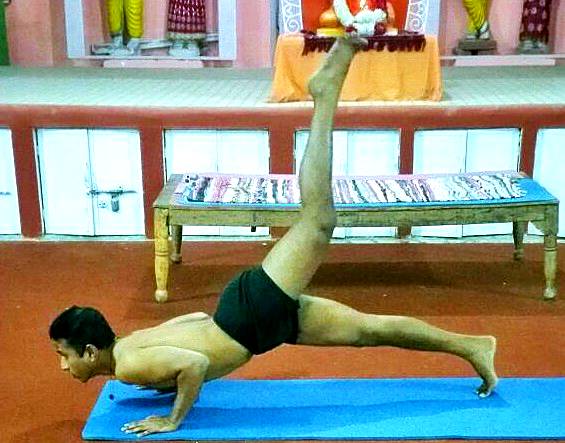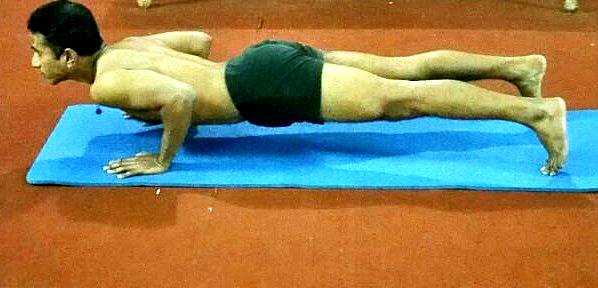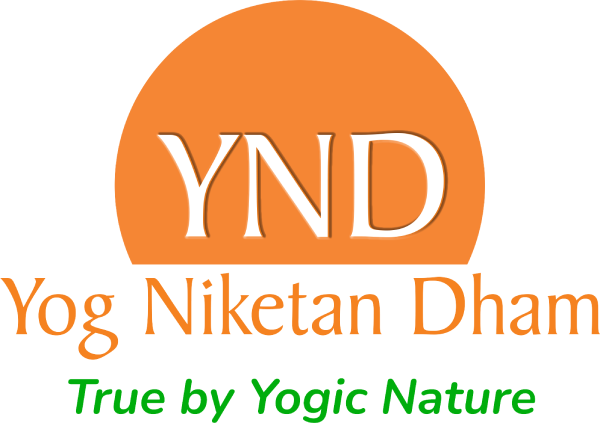Chaturanga Dandasana
Table of Contents
Chaturanga Dandasana, or four-limbed staff pose, is a momentous asana in Hatha Yoga, Ashtanga Yoga, and the Sun salutation series. In Sanskrit, Chatur means Four, Anga represents limbs, and Danda means Staff.
It resembles the spine of a human being. It is pronounced as Chaturanga-Dandasana, or “Cha-tur-anga- dandasana.” It is considered another variation of the Plank pose with different variations.

Chaturanga Dandadasna, or the four-limbed staff pose, is practiced in various yoga flows. In ancient times, Gurus asked their disciples to hold and stay in this pose for a long to develop strength and endurance and boost energy.
Chaturanga practices so frequently, especially in Surya Namaskara. Therefore, practicing the Bakasana, Astavakrasana, or Eight-Angle pose is highly recommended before attempting the Four-limbed staff pose. It is for attaining extreme balancing and coordination in body parts.
Muscles widely used in practicing Chaturanga Dandasana are:-
- Trapezius
- Deltoid
- Scapula
- Biceps
- Triceps
- Pectoralis Major
- Quadriceps
- Rectus Abdominis
- Maximus Gluteus
- Minimus Gluteus

Chaturanga Dandasana for beginners
Chaturanga Dandasana is an intermediate-level series posture that requires a lot of practice. It is practiced a lot during the Sun Salutation series, which is the most crucial time for a beginner to concentrate on this posture.
A beginner who has significantly less information about this pose may attain a good level of practicing four-limbed staff pose after following these steps:-
- After practicing the downward-facing dog pose, check the length and physiology of the body.
- Open your hands parallel to the level of your shoulders.
- Place the hands on the ground and come into plank pose (Dandasana) with hands under the shoulders. Please keep your legs parallel to the floor.
- Take a deep breath and exhale by bending your elbows. All the body weight should be on the forearms and balancing on the toes.
- It is essential to check the line of your shoulders, which will be the same as your elbows.
- Hold your breath until you return and straighten the arms again.
- Fold your legs and rest in the Vajrasana or Thunderbolt pose.
- You may also practice meditation after completing Chaturanga dandasana.
Benefits of Chaturanga Dandasana
- It increases a lot of strength in the forearms and shoulders.
- It is conducive to boosting the digestive system and activates digestive fire.
- Balancing improves after holding this asana for a long duration.
- It gives an excellent shape to the abdominal region. The biceps, Triceps, Scapula, and Trapezius are mainly affected by this pose.
- It dissolves extra fat, especially from the waist, and gives a healthy look to the body.
- It has done great work improving the coordination between the body parts.
- The Four-limbed staff pose is so helpful to awaken upper channels. Firstly, Mooladhara chakra is activated, and energy transfers to the top 3 tracks.
- It has excellent work in developing a person’s metabolism and immunity.
- Chaturanga Dandasana has excellent work activating the Manipur Chakra, which is directly connected with the digestive tract and is called the heating point of the body.
- It also supports the cardiac region. There is fast blood circulation toward the heart while holding a four-limbed staff pose.
- This posture gives you the highest level of mental balance, which helps to boost your confidence level.
- The Four-limbed staff pose effectively aligns the body parts.
- It also prepares the body’s muscles to adopt other postures.
Precautions of Chaturanga Dandasana
- Please avoid the four-limbed Staff pose if you suffer from high pulse rates or blood pressure.
- In case of severe body pain, it is advisable not to practice this asana.
- In the case of Carpal tunnel syndrome, one should not practice it.
- If someone suffers from a wrist joint problem, they should avoid it.
- People should avoid practicing four-limbed staff poses for neck, chest, and shoulder injuries.
- Avoid posture if you suffer a Cervical problem.
Note: Chaturanga Dandasana works fabulously, activating the heart chakra and the solar plexus channel. It is also helpful in activating Kundalini and has done an excellent job of neutralizing it for curing thyroid problems.
During our Yoga Teacher Training programs, we ask our students to be under the practice of Four-limbed staff pose for physical, mental, and emotional growth. Our Reiki and Yoga Therapy sessions support them in recognizing the benefits of holding Chaturanga for a specific time.
Tags:


